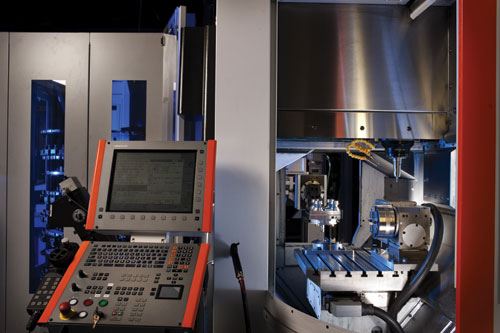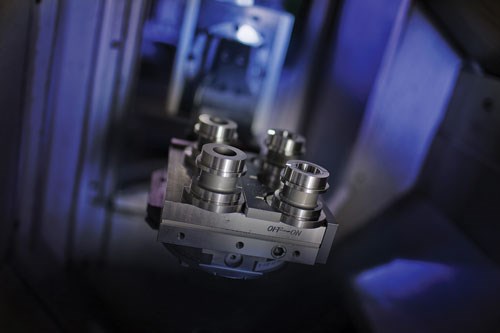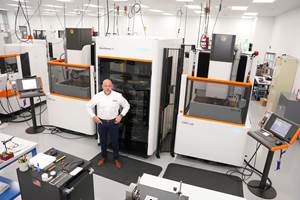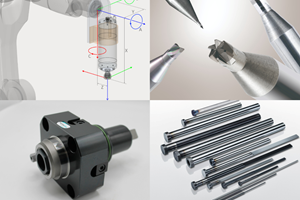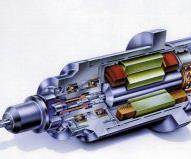2010 Leadtime Leader Award Small Shop Winner Mold Craft, Inc.: Innovation with Automation
With an average leadtime of eight weeks, Mold Craft, Inc. (Willernie, MN)—this year’s Small Shop Leadtime Leader Award Winner—builds tight-tolerance, high-volume, multi-cavity and multi-mold projects that produce small, intricate, precision plastic parts.
With an average leadtime of eight weeks, Mold Craft, Inc. (Willernie, MN)—this year’s Small Shop Leadtime Leader Award Winner—builds tight-tolerance, high-volume, multi-cavity and multi-mold projects that produce small, intricate, precision plastic parts. The company’s strength is in designing and building molds that require extensive engineering using tightly toleranced CNC machining, CNC sinker and wire EDM work, grinding and polishing. Polishing is done in-house to maintain the best control over quality. The company also builds molds for metal injection molding, LSR and LIM molds.
Mold Craft’s 40 employees manufacture these molds for the medical device, product and packaging markets; IV technology; pharmaceutical; consumer products; telecommunications and microelectronics industries. “While most of our current customers produce plastic and silicone parts for medical device and implant applications, we also provide molds for intricate microelectronic and telecommunication devices,” according to Jim Liddell, Mold Craft Sales. “Our ingenuity to design inserts for molds that can be interlocked and interchanged to provide numerous size and detail characteristics provide a less costly project expense for our customers.”
Business Strategies
According to Mold Craft VP of Engineering Justin McPhee, “Our business strategy centers on a total commitment to customer satisfaction. We make this commitment to all of our stakeholders because of our two key guiding principles of integrity and partnership. Mold Craft looks for projects where our engineering expertise allows our customers to achieve molding efficiencies that provide for successful projects. Our designs facilitate statistical process optimization through scientific molding design principles. We will maintain our industry leading prominence through nonstop innovation to be the best that we can be and commit to never stop improving our processes, employees, equipment, inspection and quality.”
Tim Bartz, Mold Craft’s VP Operations, notes that since its inception in 1964, Mold Craft has specialized in small, intricate, tight-toleranced parts—and that his employees are experts at meeting tight deadlines; even in an unsteady economy. “As with everybody in the industry, we have been fighting the tough economic recession, rising cost of healthcare and uneven trade with China,” he says. “We have used the slower times over the last year to invest in training and introduce more automation and new, more accurate equipment. Not only does this reduce or at least hold steady the cost of molds and reduce leadtimes for our customers, it also strategically positions us for increased capacity as the economy rebuilds in the prosperous years to come. In the past two and a half years, our leadtimes have decreased by as much as half for certain molds.”
Automation Success
Mold Craft has enjoyed a great deal of success with automation. “We found that adding tooling storage with a robotic interface produced higher production rates, increased productivity and resulted in better quality,” Bartz explains. “Our five-year plan was to bring in more advanced automation in early 2009. Although counterintuitive, the timing couldn’t have been better when these purchases were placed on the production floor in early 2009. In the heart of the recession, we were able to implement the new equipment and get our training behind us, which has allowed us to accelerate out of the tough times and be ready for the opportunities that 2010 has to offer.”
Mold Craft’s automation now includes tool-to-tool robotics and storage facilitation capabilities. The latest installation is the newly arrived Mikron HSM500 with simultaneous four-axis capability integrated with an existing Erowa Multi-Twin Robot that was already mated to an Agie Hyperspark 2 Sinker EDM. “Robotic interface from the mill to the sinker is enhanced with additional pallet and electrode storage using the Erowa system capable of storing an additional 45 pallets and 210 electrodes,” Bartz says. “The second piece of automation purchased this year was an Erowa ERC Robot that is able to feed 10 workpieces and 142 electrodes into a Mikron HSM 300 Graphite Master high-speed milling machine.
“Automation is a culture developed from the top and embraced by the tooling craftsmen at Mold Craft,” Bartz continues. “Highly-skilled CNC specialists strive to fully utilize the capacity of the robots and the machines each day and night, as they recognize that it ensures their future, the company’s future and the future of moldmaking in the U.S. Our plan is to introduce more automation—with results being manufacturing improvement, cost reductions for our customers and improved leadtimes.”
A Driven Workforce
Bartz declares that employees are the keys to the company’s success. “We need to ensure that they have the tools they need to do the best job they can,” he says. “We have implemented many ideas around the shop for setting up certain areas efficiently and are always looking for more. We often work as a team to schedule pieces through the shop even if it means somebody needs to come in late in the evening or on the weekend to ensure their step is complete when it is supposed to be.”
Both seasoned veterans and a newer generation of employees work together to ensure the molds get delivered on time. “The younger generation has a definite affinity to computers and technology,” Bartz notes. “With the addition of robots and the eagerness to work and do whatever it takes to get the job done, the younger generation has stepped up nicely.
“The senior employees play a vital role in mold building at Mold Craft,” Bartz continues. “With the leadtimes being compressed by as much as 30 percent from years gone by, our top toolmakers understand that they can’t take a project from start to finish and have their hands in every aspect of the build. There is a certain amount of trust and responsibility placed on all the different departments that handle and build the components for a mold.”
Controlled Growth
Liddell is working to expand Mold Craft’s visibility within its existing customer base, and expects to add one or two new customers per year. His main goal is to increase revenue with customers that are looking for multi-cavity molds for small, intricate parts. “We are specifically looking for those clients where our attention to detail on the front end of the project providing unique design concepts to save time and money will benefit the program,” he comments. “The company is also looking toward complex projects using multi-shot, overmold and stack mold technology.”
Additionally, Mold Craft plans on keeping the company lean throughout 2010 while continuing to plan for the future. “We will get rid of the equipment that is not making money but taking up valuable floor space, and replace it with profitable, state-of-the-art machines and robots that will enhance our customer offerings and solidify promise dates,” Bartz notes. “Our philosophy on machines is that you cannot fall in love with the equipment. After it has served its purpose and is not quite as efficient or accurate as it used to be, it needs to be replaced. Our very skilled toolmakers and machine specialists embrace the technology as it not only challenges them to think differently, it gives them a great sense of accomplishment to see how much work they can complete in a 24-hour day—not simply an eight-hour day.”
Related Content
Advancing Moldmaking and Plastics: Trends in 3D Printing, Automation and Sustainability
NPE 2024 showcased the latest trends and technologies in innovation, efficiency and sustainability for moldmakers and molders, featuring advancements in 3D printing, automation, design and virtual reality/augmented reality/artificial intelligence.
Read MoreMold Builder Meets Increased Domestic Demand With Automated Cells
Burteck LLC experienced significant demand increases due to reshoring and invested in automated machining cells to step up its production output quickly and avoid losing business.
Read MoreTechnology Roundup: New/Improved Technologies You Don't Want to Miss
With all the technology joining the market, moldmaking is a versatile, ever-evolving industry. As such, this technology roundup has no specific theme — it features a variety of products for applications and solutions across the industry.
Read MoreDevelopments in High-Speed Machining Technology
There have been many exciting developments in high-speed machining relative to machining centers and controls, tooling and CAD/CAM systems.
Read MoreRead Next
How to Use Strategic Planning Tools, Data to Manage the Human Side of Business
Q&A with Marion Wells, MMT EAB member and founder of Human Asset Management.
Read MoreAre You a Moldmaker Considering 3D Printing? Consider the 3D Printing Workshop at NPE2024
Presentations will cover 3D printing for mold tooling, material innovation, product development, bridge production and full-scale, high-volume additive manufacturing.
Read MoreHow to Use Continuing Education to Remain Competitive in Moldmaking
Continued training helps moldmakers make tooling decisions and properly use the latest cutting tool to efficiently machine high-quality molds.
Read More
